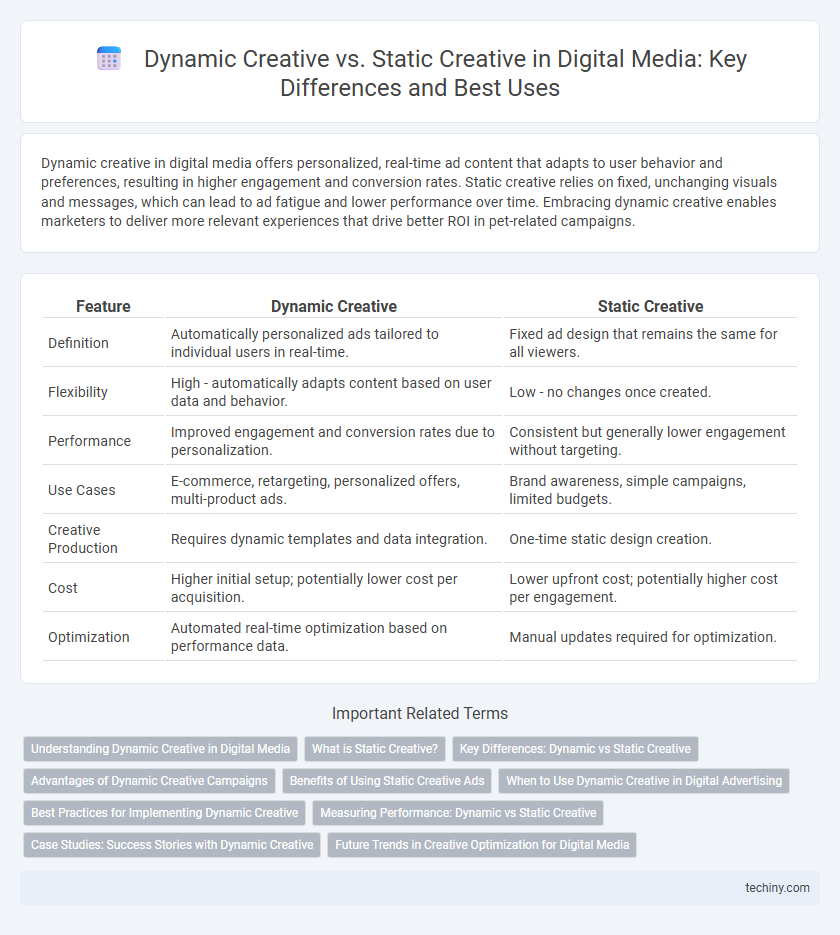Dynamic creative in digital media offers personalized, real-time ad content that adapts to user behavior and preferences, resulting in higher engagement and conversion rates. Static creative relies on fixed, unchanging visuals and messages, which can lead to ad fatigue and lower performance over time. Embracing dynamic creative enables marketers to deliver more relevant experiences that drive better ROI in pet-related campaigns.
Table of Comparison
| Feature | Dynamic Creative | Static Creative |
|---|---|---|
| Definition | Automatically personalized ads tailored to individual users in real-time. | Fixed ad design that remains the same for all viewers. |
| Flexibility | High - automatically adapts content based on user data and behavior. | Low - no changes once created. |
| Performance | Improved engagement and conversion rates due to personalization. | Consistent but generally lower engagement without targeting. |
| Use Cases | E-commerce, retargeting, personalized offers, multi-product ads. | Brand awareness, simple campaigns, limited budgets. |
| Creative Production | Requires dynamic templates and data integration. | One-time static design creation. |
| Cost | Higher initial setup; potentially lower cost per acquisition. | Lower upfront cost; potentially higher cost per engagement. |
| Optimization | Automated real-time optimization based on performance data. | Manual updates required for optimization. |
Understanding Dynamic Creative in Digital Media
Dynamic creative in digital media leverages real-time data and automation to tailor advertisements to individual users, enhancing relevance and engagement. Unlike static creative, which remains fixed and uniform, dynamic creative adapts visuals, copy, and offers based on user behavior, location, and demographics. This data-driven customization boosts campaign performance by delivering personalized content that resonates with target audiences across multiple digital platforms.
What is Static Creative?
Static Creative in digital media refers to fixed advertisements that do not change or adapt once launched, often comprising a single image or video designed to convey a specific message. These creatives offer consistent branding and messaging but lack the ability to personalize content based on user data or behavior. Common formats include banner ads, static social media images, and email graphics designed for broad audience targeting without real-time customization.
Key Differences: Dynamic vs Static Creative
Dynamic creative adapts content in real-time based on user data and behavior, offering personalized ads that improve engagement and conversion rates. Static creative delivers fixed, unchanging content designed for broad audiences without tailoring to individual preferences. The key difference lies in dynamic creative's flexibility and data-driven customization versus static creative's consistency and simplicity.
Advantages of Dynamic Creative Campaigns
Dynamic creative campaigns leverage real-time data to tailor advertisements, boosting engagement and conversion rates by delivering personalized content to individual users. These campaigns enable efficient multivariate testing, optimizing performance through automated adjustments based on user behavior and preferences. Enhanced scalability and adaptability in dynamic creatives reduce manual effort and increase relevance, driving higher ROI compared to static creative campaigns.
Benefits of Using Static Creative Ads
Static creative ads excel in delivering clear and consistent brand messaging through visually stable and easily recognizable images. They require fewer resources and lower production costs compared to dynamic creatives, making them ideal for campaigns with tight budgets or quick turnaround times. Static ads also ensure faster loading times, increasing user engagement across various digital platforms and devices.
When to Use Dynamic Creative in Digital Advertising
Dynamic creative excels in digital advertising when targeting diverse audience segments with personalized content at scale, significantly enhancing engagement and conversion rates. It is particularly effective for campaigns requiring real-time optimization and adaptation based on user behavior, demographics, or contextual data. Utilizing dynamic creative is ideal for e-commerce, retargeting, and performance-driven marketing strategies where continuous performance improvement is critical.
Best Practices for Implementing Dynamic Creative
Dynamic Creative relies on real-time data to tailor ad content, making it essential to segment audiences precisely for maximum relevance. Use A/B testing to continuously optimize creative elements such as images, headlines, and calls-to-action based on performance metrics. Ensure seamless integration with ad platforms like Google Ads and Facebook Ads for automated personalization and efficient scale.
Measuring Performance: Dynamic vs Static Creative
Dynamic creative uses real-time data to tailor ads for each user, resulting in higher engagement rates and improved conversion metrics compared to static creative's uniform approach. Performance measurement for dynamic creative leverages granular analytics such as click-through rates (CTR) and conversion rates segmented by demographics and behaviors, enabling precise optimization. Static creative performance typically relies on broader metrics like overall impressions and average CTR, which can mask variations in audience response and limit actionable insights.
Case Studies: Success Stories with Dynamic Creative
Case studies reveal that Dynamic Creative significantly boosts ad performance compared to Static Creative by delivering personalized content that adapts in real-time to user preferences. Brands like Coca-Cola and Nike have experienced up to 30% higher engagement rates and increased conversion rates by utilizing dynamic ad formats that respond to audience behavior and contextual data. Data-driven success stories demonstrate how Dynamic Creative enables marketers to optimize campaigns efficiently, resulting in improved ROI and stronger customer connections.
Future Trends in Creative Optimization for Digital Media
Dynamic creative leverages real-time data and AI to tailor advertisements to individual user behavior, driving higher engagement and conversion rates compared to static creative. Future trends indicate growing adoption of machine learning algorithms that continuously optimize ad elements such as visuals, messaging, and CTAs for diverse audience segments across multiple platforms. This evolution in creative optimization maximizes campaign efficiency and personalizes user experiences, making dynamic creative a cornerstone of digital media strategies moving forward.
Dynamic Creative vs Static Creative Infographic

 techiny.com
techiny.com